| Introduction
This is another transcript (revised) in the Warwickshire County Record Office’s Healey Archive “Oral History” series. As I have mentioned before, the process is for people with connections with Healey, e.g. employees, suppliers, or, owners of Healey cars, to record their memories of that association. A volunteer, I am one, then either visits them at their home, as in this case, or meets them at the Record Office, in order to conduct an interview. The conversation is recorded and afterwards transcribed. Researchers can listen to the recordings at the Record Office, Warwick, or read the verbatim transcript, ‘online’, in the Healey Archive Catalogue. To some researchers the “verbatim” aspect of these recordings and transcripts are very important but the latter are not easy to read and there are no photographs to illustrate what has been said. So, I decided to “tidy up” some of the transcripts to make them more accessible to Healey enthusiasts. As I say, this is another one of those “tidied” versions. The key elements of this interview/story are –
This was a very long interview, so, I have split it into two parts. I will despatch the second part in two weeks time. Part One – Love at first sight Interviewer: Well David we have done our introductions, would you now like to record your memories of owning an Austin Healey 3000 MK. III for such a long time. “I think the first thing to say is that I’ve always been a car enthusiast. My father was very much into motor racing, although not really a driver of exotic cars. He followed motor racing during the 1930’s and that rubbed off on me. While we were driving around when my brother and I were children, he’d be commenting on all the cars we’d see, especially if they were of particular interest. He also took us to motor races, one that I particularly remember was the Shelsley Walsh Hill Climb. I have since found out that the date of that visit was June 1950. The Shelesy Wash Hill Climb was to become a big part of my life in later years.” Interviewer: Was that the first one you went to? “Yes, that was the first time I was taken to see a motor racing competition. Needless to say, I was only, what, around about three years of age so my memories are not particularly vigorous, but I do remember. I have a very clear picture in my mind of the hill side and where we were sat, but, of course, I can’t remember anything of the cars. Subconsciously it must have had a big impact on me because now I’m the MAC archivist and, of course, I have all the records, I can look at all the records going back decades..” Interviewer: MAC, is that the Midlands Automobile Club? “Yes, the Midland Automobile Club have always run Shelsley Walsh, so, that was my first experience. The same year we also went to the British Grand Prix which was the famous one when the BRM V16 appeared, with much expectation. Raymond Sommer (a pre and post WWII French racing driver. One of his claims to fame is that he gained Enzo Ferrari’s first win as an independent constructor. NM) let the clutch in, sheared both the half-shafts and it never moved. But, again, I can’t remember that, I picked that up since.” Interviewer: Where was that, was that at Silverstone? “That was at Silverstone. Yes. I think I’m right in saying that was actually the first round of of that year’s Formual One World Championship (which also saw the introduction of the World Championship for drivers. NM) So, that was what got me interested in cars and a, sort of, broad interest as well, not narrow in any particular make. But, they always say that the cars that you love are the ones that you drool after, just before you get your first licence and for me, that was definitely the Austin-Healey.” Interviewer: Interesting, as early as that? “Yes, from about twelve or thirteen onwards, which would have been what, 1959, 1960, ‘THE’ car for me to see was the Austin-Healey 100. If I saw one going past; I’m also a big fan of noise, so the exhaust note has got to be right and as far as I’m concerned, the only decent engine is either an inline-six or a V12. As an engineer, for me, an inline-six looks right and sounds right. So, by ’59 of course, you were at the 100/6, and the 3000 was just coming along. So, for me, they all made the right sound, they also looked good. My target, as soon as I could drive, was to be able to get one. At school I had a lot of friends who were also into cars, so, we would all pour over Autocar and Motor magazines. I also bought Motorsport magazine from a very early age. I still buy it today. So, after ‘A’ Levels (equivalent to High School graduation exams. NM), I was duly launched into the big wide world looking forward to the day when I’d have a job and could buy an Austin-Healey.” Interviewer: It’s interesting that you were so focussed, even then. I think that’s unusual. “Yes, I appreciated the exotics like Ferraris, Maseratis, etc., but always assumed that the monetary side would prevent me from having one. Another thing that used to very much interest me was that, we lived in a place called Sunbury-on-Thames, which is just across the river from Walton-on-Thames where HWM Motors were located. (Hersham and Walton Motors – they built racing cars from 1950 to 57, Stirling Moss, Peter Collins and Paul Frère all made their GP debuts in HWM cars. HWM, as a car dealer, still exists to day and is the World’s oldest Aston Martin dealer. NM) This was the company that George Abecassis, a well-known racing driver at the time, owned. He also had a franchise for Maseratis’ and other exotica, so, we would often go across the river and press our noses against the windows to look at the lovely cars, but of course it wasn’t an Austin-Healey. Fast-forward to the end of school days. I signed on for a student apprenticeship at Perkins Engines in Peterborough, makers of diesel engines, which, of course, then led me basically for the rest of my life to be involved with diesel engines and automotive activities, shall we say. But never actually in the car business. So, engines were it, for me, and of course, first I had to go through the apprentice phase, which was like a sandwich, doing a Higher National Diploma in Mechanical Engineering. Part of the time I would be at college and then, during the summer, I’d be back at the factory. So, with the meagre earnings from my employment I managed to buy myself an Austin A30, in 1966. I kept that car for about a year and, it would have been in 1967, I think, that we went on a College trip, that took us via the bypass around Leicester. There, on a car sales lot, was a Healey 100/4. I thought, well, I have got to go back and see that. The following weekend, I drove back to Leicester to have a look at it. It looked to be reasonably sound. The bottoms of the doors were rotting but that was fairly normal. I didn’t know much detail about Healey’s then, all I knew was that the age of the car was 1953, so it was a pretty early one. 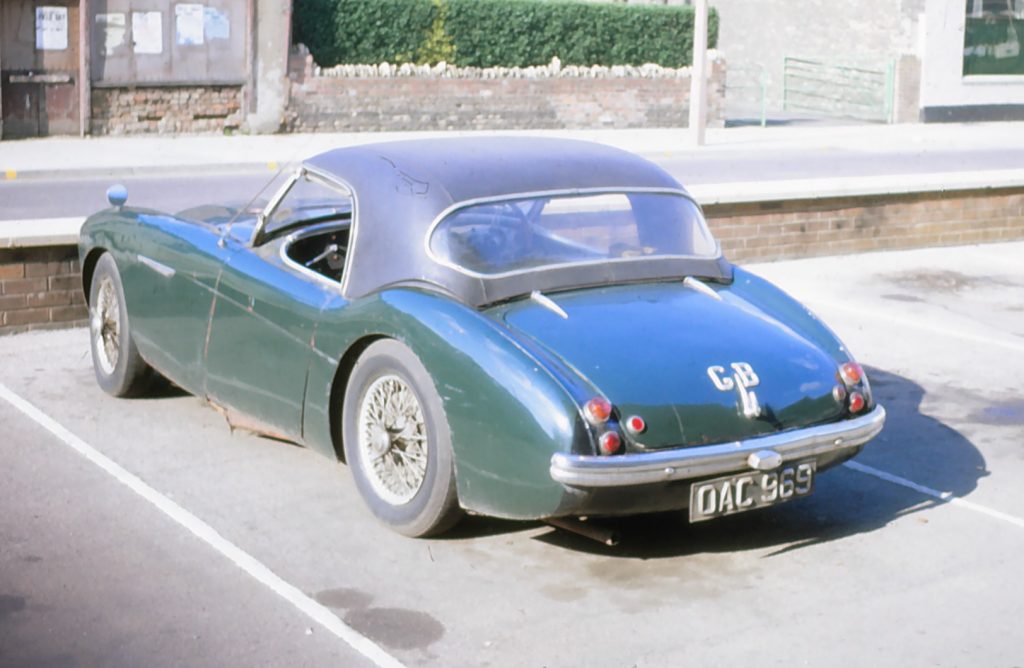
It was runnable. It didn’t have a soft top, but it did have a hard top. Many, many years later, I met John Wheatley, who was formerly the AHC 100/4 Registrar; he identified the manufacturer and said it was a very expensive hard top. It also had a very tatty Tonneau Cover. It ran okay and I ran it for about a year until my student grant money ran out and I had to sell it, unfortunately. Its registration was OAC 969 and I have obtained a copy of the registration document, from the Warwickshire Record Office, which shows it was registered on the 27th of November 1953 by the Donald Healey Motor Company. I have been in touch with the AHC Registrar who told me that they’ve got OAC 966, 967, 968, 970, 971, but they haven’t got 969. So, the car appears to have disappeared off the face of the earth. I sold it to a student from Loughborough University who said that he was going to rebuild it. Now, that may well have been the case but, as we all know, there are many people who have taken cars to bits and they find that the time and effort it takes to put them back together again is beyond them.” Interviewer: Both time-wise and financially. “And we don’t know whether it’s been scrapped, whether it was a basket-case and somebody has bought it and used it for another car, or of course, it could have been rebuilt and sold abroad. We just don’t know and despite making requests to magazines and things, I’ve never managed to get any information. As to the car itself, I have to say I had a passionate dislike of MGBs and I used to have great delight in seeing them off with this car. The bottom-end torque was just fantastic. I mean, you’ve got to remember that the 100/4 engines red-lined at four thousand revs, so, it’s not a car to be revved. With a three-speed gear box with over-drive, which, incidentally, was still working, although some idiot had wired-out the reverse inhibitor. So, normally, when you put it into reverse, it’s impossible to engage the overdrive. The switch must have failed, so somebody wired it out which caused it to make the most horrible noises when you put it into reverse. I very quickly had to get that fixed. But other than that, it was good fun to drive. The handling was, obviously, very impressive compared to the A30 and I used to enjoy driving it a lot, it was sad when I had to see it go. Practicality weighed in and I had to buy a minivan after that, which all students used to have.” Interviewer: Me too. I had a minivan. 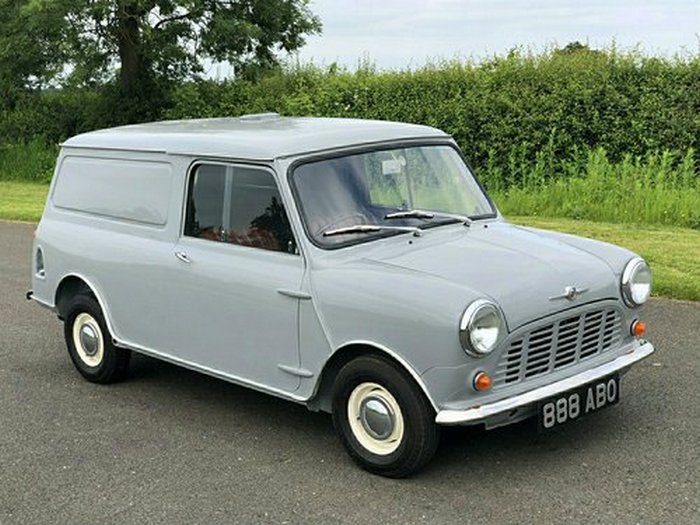 “Because you remember, you don’t have to pay purchase tax on it.” Interviewer: Correct. “So, the minivan was the thing to see out my apprenticeship and once I’d got my first job at Perkins and had a little bit of money to play with, I bought myself an eighteen-month old Triumph Vitesse 2 litre. I thoroughly enjoyed this car because it had the right number of cylinders (six) which was the primary reason for me having it. It had good performance and impressive economy for a 2-litre car and I ran that for fifty thousand miles, I think. But the niggle that was still there, “it’s not an Austin-Healey” I was very involved with rowing in those days. I’ve been an oarsman since my school days, it was a rowing school I went to. I’m still rowing today.” Interviewer: On the Avon? “Yes. I was very active, rowing a lot in those days, this was before I was married and one of my crew mates said to me “If you ever wanted to sell this car (the Vitesse), I’d be interested in buying it”. So, I thought, yes, it’s time I got an Austin-Healey again. So, I got a little bit side-lined by falling in love with AC Ace’s but having spent seven months trying to get one and failing, I thought, right, go back to first love. I saw an advertisement in the back of Motorsport (magazine) for a 3000 Mark III by Lenham Sports Cars. They were the firm that used to make fibreglass bonnets for Sprites and Spitfires, etc. and hard tops, very attractive ones. By the way, the car was for sale for £695, which sounds quite comical today.” Interviewer: Just remind me of the time, what year are we talking about? “We are now talking August 1972. So, I rang them up and said “Your claim in the advert that this is in very, very good condition, I’ve had a Healey, I know where they rust, so, if the front wing is rotted out, I’m not interested”. And he said “Oh, no, no. The car is very sound. We’ve resprayed it and retrimmed it and” blah, blah, blah. So, I thought, well, the only thing to do is to go and see it. So, I drove down to Kent to where they are located, alongside the M20, which is very convenient, for road-testing cars. I went through to the, workshop where the car was. When I saw it I thought to my self “Wow”. It looked brand new. It had got new number plates, it had been very professionally resprayed, it had been re-trimmed. The hood was new, so, I thought, well, I can’t afford not to have this car, because the price was about right. I road tested it and it seemed to be fine. I gave it the beans quite a fair bit, but the chap said to me, “Oh, you do remember that, I did tell you, that the engine has been rebuilt?”, obviously wanting me not to give it too much welly (pedal to the floor). And I thought, hmm, yes, we’ve all heard salesmen say that, it tends to suggest something’s wrong, but I couldn’t detect anything wrong with it, so, I agreed to buy it. I paid a deposit and said I would be back next week. They wouldn’t take my Vitesse in part exchange because it wasn’t a sports car. So, I sold that to my crew mate, went back to Kent on the train and duly collected the car.” August 1972 then saw me as the owner of an Austin Healey again. Once I had got the 3000, I began to learn a lot more about it, in terms of the differences between models. The first thing you have to recognise with Healeys is that there is never a clean model change. “ Interviewer: Did you say what Mark this is? “It’s a Mark III. A very early one, so, that means it has the indicator and side-light combined, but it also has the Mark II chassis. Because the main, sort of, USP of the Mark III was the fact that you had the 150 bhp engine with the twin SU carbs, centre-change gearbox and wooden dashboard. All Mark IIIs have got those features but at chassis number 26705, they changed to the drop-frame underneath the axle, like the Works Rally cars. The TPI (threads per inch) of the lock-on hubcaps changes to a coarser thread, and the brake calipers were larger. I knew nothing about this when I got the car. The first thing I do is drive up from Kent to my parent’s house in Sunbury (Surrey), which is where these photographs were taken, so this is collection day and … 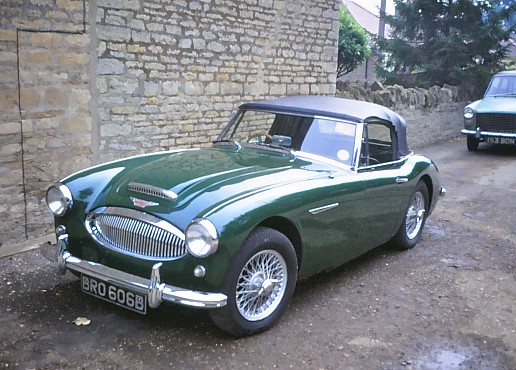 Interviewer: You mentioned it looking almost brand new and it does, I can confirm that it looks absolutely terrific. “My view was, that even if something did go wrong with it, if some rot did appear, it was going to be a good buy. Bear in mind, the car was only eight years old, this was August ’72 and it was registered on the 21st of May ’64, so it’s not particularly old. I then drove it up to Peterborough, which was a good experience of getting to know the car. Over the ensuing weeks, I got braver and braver with it. Living at Peterborough, not far from the A1, which is where everybody tended to max their cars, I did find out what the problem with it was, although I didn’t know what the cause was. I found that if you drove it flat-out through the gears, you would hit just over ninety miles an hour, then you would suddenly hear a change in the engine note and feel the performance going off. It would also then spit back through the carburettors.” Interviewer: So, this is max revs in each gear? “In each gear yes and so, with normal driving you would never have any problem. This was a bit of a mystery to me: I had the carbs off, cleaned them out and checked the distributor etc., the points and everything, nothing seemed to be amiss, so it was still a mystery. I, sort of, rather ignored it for a little while and just got on with enjoying driving it. Then, in the space of six weeks, three of us at Perkins had bought Healeys. One of my close work mates bought a Mark II, ..” Interviewer: Were they influenced by you to some extent? “No, no. My work mate, who bought a Mark II, bought it because he had two young children and when he was a youngster, his father had bought a 100/4, so, he had the memories of it as a child, sitting in the back of a 100/4 with the wind through his hair. He said “I want my children to experience this as well”. So, he picked up a Mark II for the very reasonable price of £400. The third chap, who was in our Sales Department, had an almost immaculate Mk II and one evening he said, “Why don’t you all come round for a beer and I’ve got a pit in my garage and we’ll put the cars over and we’ll have a look at them underneath”. This was very interesting as both of their cars turned out to have had front-end impacts, because if you hit the nearside of a Healey, it almost inevitably bends the nearside chassis frame at the strong point of the scuttle. So, what had been done to repair them was to cut the chassis off at forty-five degrees and weld on a new chassis leg.” Interviewer: So, it was easily identifiable that that had happened. “Both their cars had had that done and mine hadn’t. But, the owner of the house went down the pit as I drove over it, and he said, “There’s your problem”. The fuel pipe had been crushed against the chassis, over a length of about six inches, which was very easy to rectify. So, a couple of nights later I just cut that piece of pipe out and I found I could hardly blow any water through it when I took the pipe off. Of course, with the pipe repaired, I went straight out onto the A1 and tried it again and it just ran cleanly at a hundred and twenty mph! Of course, the loss of power had been because the fuel mixture was weakening. Fortunately, I realised that and took my foot off the throttle, because, if you run on lean mixture you can start to melt pistons. So, that was it. We now had a Healey that looked beautiful, was running right and I was happy as Larry. So, the next thing I thought was, “Well, I ought to start doing a bit of motor sport with this, really, I suppose”. “ Interviewer: Incidentally, what mileage was on the car when you bought it? “They didn’t know and they had put a new speedo into it, you know, with the sticker on saying so, thus I had no idea what mileage it was on. I know that I’ve done about a hundred and twenty thousand in it, I think …” Interviewer: What, now? Now you’ve done a hundred and twenty thousand miles? “Yes. But, what the mileage was then, I don’t know. If we assume the average of twelve thousand a year, then it should have been just under a hundred thousand, I suppose. It would have been enough for the engine to have been rebuilt, which I’ll come back to later. I was a member of the Vintage Sports-Car Club, at this time, because as I mentioned earlier, I’ve always been very interested in a wide variety of cars. I suppose you can say that my interest really, is for what I call the ‘wire wheel’ era. You know, as modern as a GT40, but as early as 1920 cars. So, I joined the VSCC very early on and the Pomeroy Trophy is the only event you can enter in a modern car. Have you heard of the ‘Pom’ Trophy?” Interviewer: Vaguely but I don’t know much about it. “Well, the ‘Pom’ was named after Laurence Pomeroy, the famous Vauxhall designer: he and son Laurence Pomeroy Junior decided to try and come up with a magic formula to determine what the best car of any era was. This was done by establishing various tests which have to be completed in a certain time. The times you achieve in your car earn you so many points, etc. So, you can see (referring to a photograph) there is a wide variety of cars. There is a 275 short-wheel base Ferrari on the left and there, alongside me, looks like a 30-98 Vauxhall. Behind that you can see there is a Healey Alvis.” 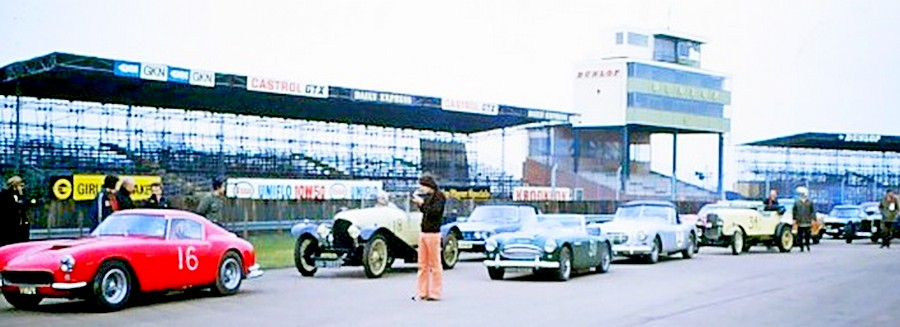 Interviewer: Yes. That is a very rare car. “They only made twenty-five of them, I think. Needless to say, the owner and I had quite a conversation. I had enormous fun doing it, but the …” Interviewer: How many laps was that? “Well, in fact, in those days, if you were entering the thing, they had to have a method of ensuring that you hadn’t produced some sort of Special, tuned-up to the nines, so, they had an hour high speed blind going round the Silverstone Club circuit which was tremendous fun. After two laps, I suddenly realised that I hadn’t got any brakes; as a good friend of mine always says, “Well, you don’t need brakes, they only slow you down”. When I say I hadn’t got any brakes, I mean, it felt like no brakes, but, bearing in mind the Mark III was the first Healey to have a servo as standard, I thought, well, it’s braking evenly, so, there is nothing wrong with the brakes themselves, it’s probably the servo that’s playing up. I proceeded to just drive for a couple of laps a bit more carefully. Of course, everything came past me, I was on the front row of the grid at the start, had shot off and left a lot of the cars behind. Now, they all started coming past me, the 3-litre and 8-litre Bentley’s, once they got wound up tore past me. I then realised that the brakes came back again; I came to the conclusion that it was probably the evacuation rate of the servo that was not very good. I found that I could do a lap of the Club circuit and only use the brakes once for Woodcote corner. The rest of the time I would just throw the car into the bends. It made the most horrible racket on road tyres, the squealing from tyres is dreadful. Anyway, I found I could go along the Club straight and go into the corner at the end of the Club straight, at about ninety, and hold it through there in a, sort of, drift. I thought “Well, this is great fun”. Through Becketts, onto the Club straight and then, of course, you have to brake hard for Woodcote, the servo would support that. I thoroughly enjoyed myself for an hour and the servo was another thing to look at when I got back home. I didn’t win any awards and in fact I never have seen a Healey win an award in the ‘Pom’ Trophy. If you’ve got an AC Ace, particularly an Ace-Bristol, you will always get a First Class award.” Interviewer: Because of the formula that’s been worked out? “Yes. Because it has a 2-litre engine, phenomenal handling, very light, very quick on acceleration, the Healey at 3-litres is expected to be quicker than it is. So, I think if you were probably an absolute demon driver, which I’m not, you might just scrape a third-class award, but I’ve never seen an Austin Healey achieve any awards.” Interviewer: Do they still run the Pomeroy Trophy? “Yes, it was run in February and it was very popular, but it’s been losing entries. Now, the hour blind, if it’s still an hour, is done on the Grand Prix circuit, so, much more fun and the entry list has gone up again.” Interviewer: You don’t drive in it now though? “No. No, I haven’t, I don’t trust myself now at seventy-one. It’s probably a bit silly. So, that was it for that year. I then entered the following year, in 1974, and you remember, that was the petrol crisis? So, the hour blind came down to half an hour, that was a shame but, in the meantime, of course, as soon as I’d got back home after the ‘73 ’Pom’, I had to find out what was wrong with the servo. I had to investigate why the servo wasn’t behaving and I soon found what the problem was, it was the servo hose, which, is reinforced to resist atmospheric pressure. This had collapsed internally so, it was getting a bit like the fuel pipe. I just got a new piece of vacuum hose, put it on, and it was perfect after that. By the time I got there in ’74, of course, I had better-performing brakes, so, I was much happier. The other learning experience from entering the second time I did it, I thought that I really ought to make sure I’d got a new set of brake pads on the front. I went down to my local parts shop, a non-franchise operation, it wasn’t a BMC place. I said that I wanted pads for a Mark III 3000 and was given this box to look through. I thought “Surely they are not the same as I’ve got?”. Anyway, I took them. I removed the ones from my car and found them to be completely different to the ones that I had just bought. So, I went straight back, with one of them, and said ,“These aren’t right for my car”. “These are mine”, showing the chap the ones that I had taken off my car. He looked a bit dumbfounded. I said, “Have you got a set of pads for a Mark II, by any chance?”. “Yes, I think so” he replied. That’s when I learned that early Mark IIIs, as I mentioned, 26705 is the first one with all the goodies on it i.e. the full Mark III, mine is 26684, so it’s twenty-one chassis before the change. So, I’ve got a Mark II chassis, Mark II calipers, and Mark II TPI (threads per inch) on the hub spinners. So, once you know that, …” Interviewer: But, as you say, you had to learn the hard way. “Likewise, one of my colleagues in the Development Department at Perkins, had a very, very early 3000 and it wasn’t a 3000, it was a 100/6 with a 3-litre engine in it. So, exactly the same way that BMC, obviously, for a low volume car used to exhaust the parts bin before they introduced the full update of the car. So, there we are in 1974 doing the ‘Pom’. I managed to do such a spectacular performance in the braking test that Bill Boddy, editor of Motor Sport magazine, commented on me in his write-up of the event.” 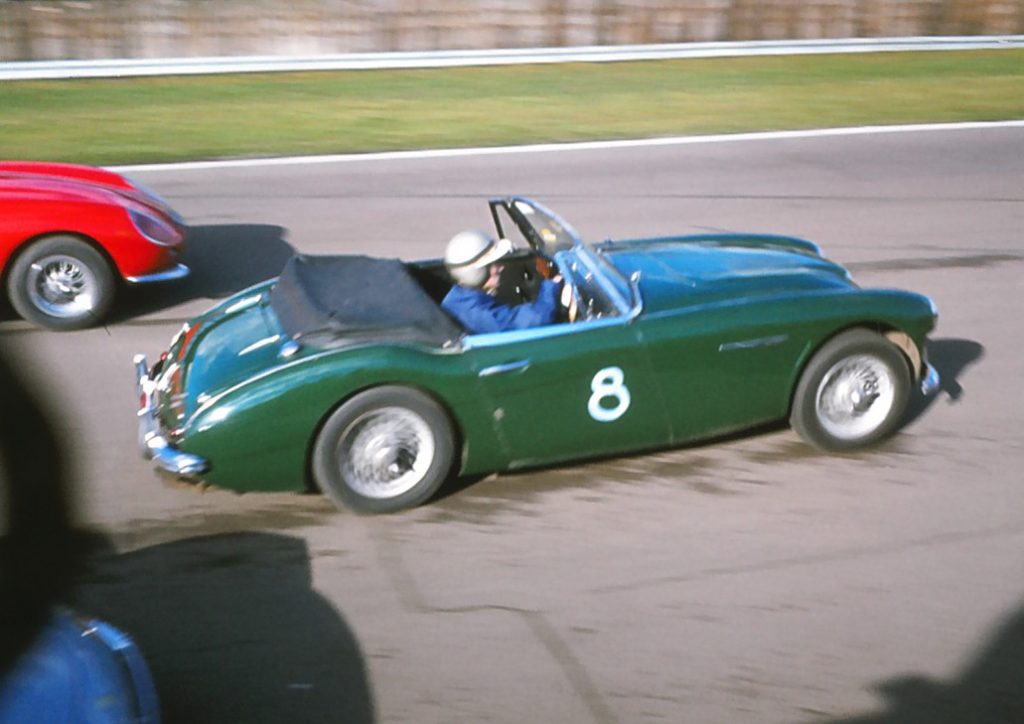 Interviewer: What an accolade! “I think he famously said, “Moore managed the braking test, despite getting a bit sideways”. This was quite amusing, because as I went into the test, they had a line where they dropped a flag, then you accelerated away from standstill. At the other end of the Club straight, there was another white line with another chap with a flag and you had to stop astride the line. The year before, I realised I’d braked far too early. This time I hit the brakes at the last minute, partially locked up the front and slewed sideways across the line. The judge looked at it and he said “Well, all it says, it’s got to be two wheels one side and two wheels the other. It doesn’t say which pair and the fact you’ve got the near side pair over it and the offside on the line, it doesn’t matter”. I got the third quickest time, behind two Ferraris, which I thought was quite good. The brakes on Healeys, if they are working properly, can be quite effective. So, here we are in 1974. In 1974 I was having great fun with the fuel crisis because you were having to go from petrol station to petrol station to try and find fuel. An opportunity came up, still working for Perkins in Peterborough, to be based down in Slough working at an engine research company. We installed test beds from Peterborough there and I had the job of managing them. It was from there that I went to the ’74 ‘Pom’. The problem was, just driving around in overdrive top everywhere at 1000 revs trying to spin out the meagre allowance of fuel you could get. But I never actually ran out. There was a blanket fifty miles an hour speed limit, if you remember, when the fuel crisis was on? Interviewer: I remember the fuel crisis but, frankly, I can’t remember it affecting me and I’m thinking what vehicle I had then. I would have had the minivan which in theory was limited by law to 40 mph. So the fuel consumption wouldn’t be too bad. And, as I say, I don’t remember it being a particular problem to me. “Well, the Healey, even driving it very gently, you’ll do very well to get twenty-three to the gallon. That reminds of a journey I was making to visit my parents for Christmas. I was driving down the M1 and I have to confess to be doing about 100 mph when an electric train came alongside me on that section by Watford Gap.” Interviewer: I know it well. “The driver was hanging out of the cab waving because he was obviously doing a hundred too. The car always used to maintain, when stinking hot at full revs, forty PSI (oil pressure), I suddenly noticed that I’d only got thirty. I thought, “Oh oh”, backed off and pulled off into Newport Pagnell service station. There was a rattling noise when I revved the engine and I realised that I’d knocked a Big End out. So, on Boxing Day I was underneath the car, with the sump off, in dad’s garage. I went to the local Partco depot and got a new set of shells. We found the offending Big End, put new shells in and …” Interviewer: It hadn’t scored the journal? “Yes, they were scored a little but with new shells it was o.k. to drive. I filled it up with oil, fitted a new oil filter and just drove back to Peterborough very, carefully. When I got home I took the engine out and was appalled to find, when I took the head off, that the idiot who’d rebuilt the engine, before I bought the car from Lenham’s, had, obviously, not known what he was doing; he had rebuilt it with Austin Westminster pistons. These were dished giving an 8:3, instead of 9.1, compression ratio. So, I was hoping I was just going to have to grind the crank and put new bearings in. But as soon as I saw the state of play, I thought, “Dear oh dear”. I also found that the camshaft was absolutely “goosed”, over forty thou’ had been worn off the lobes.” Interviewer: It suggests that it hadn’t been hardened properly for that to have happened. “Apparently, if you read the Healey books, in the early days of the Mark III, there were new oils about, these contained wear inhibitors that made “running in” engines quite difficult. They do say, I think it’s in Peter Browning’s book, that MG had a lot of problems with poor bedding in and then, as a result of that, they had still got high spots on the cam lobes These would then wear once the engine started to be used hard. I don’t quite buy into that but in any case, the net result was the camshaft was not in good shape. So, I thought “with low compression and a worn camshaft, I’m actually experiencing quite a loss of power here”. I then went to Marshall’s who were the BMC agents in Peterborough to buy a new camshaft. By the way, I haven’t mentioned that soon after I had bought the car, I went straight to Marshalls and spoke to the spare parts manager. His response after me telling him at I had just bought an Austin Healey 3000 was “Oh, I wish you’d let us know you’d got one, we’ve just taken all our stock of body panels, chassis parts etc., down to the scrapyard”. His reasoning was that there wasn’t anybody in Peterborough with an Austin Healey and they never sold any parts. This was only four years after the car went out of production! “Which scrapyard?” I asked. I shot down there, and the guy said that, “Because, they were just metal panels we cut them all up as soon as we got them”. I was furious. The only thing I did get from Marshalls was a BMC manual. They’d hardly got anything else. I asked if they had got a camshaft and they said “You must be joking, they are unobtainable. You won’t be able to get one of those anywhere”. I then thought “why am I getting a standard camshaft anyway?” There was a guy called Syd Segal, I don’t know whether he is still alive now, probably not, (Syd Segal, a Brit, was a great campaigner of a Modsport AH 3000 in the 1970s, he died in 1990. NM) he used to race and rally Healeys. He was advertising what he called a “road rally camshaft, so, I bought one from him which the car has still got. I’ve miked it up (measured with a micrometer) every time I’ve taken the engine out and it has absolutely no wear on it at all. It has a longer dwell angle for the full opening of the inlet valve. So, I rebuilt the engine but, unfortunately due to having to buy a new camshaft, I couldn’t afford to buy the new pistons too; I had to put the Westminster pistons back in and just put …” Interviewer: The bores were okay? “Sort of. There was a bit of a lip on them but I couldn’t afford a rebore so I put the Westminster pistons and rings back in but it was disastrous. The car ran a bit better because of the better camshaft but the oil consumption was terrible, ninety miles to the pint, if I was lucky. That is what a Jaguar E-type would do when they were new. But, this was not as good as I used to get before which was two hundred to the pint. So, that was it, that’s all I could afford to do at the time. The next thing to appear on the scene was Austin Healey Spares, God bless them. They were operating from a little lean-to shed in Whitnash, Leamington Spa, at the time, started by Fred Draper who was Donald Healey’s parts man. They arrived at the right time and I could always get what I wanted from them. Later on, they started reverse engineering i.e. copying existing components rather than relying on dwindling supplies of original BMC supplied parts. I always used to get gasket sets and other parts from them. That made life, running a Healey, marvellous. I never had any problems from that parts supplier. So, as I mentioned, my wife and I got engaged. My wife often reminds me that, all I brought to the wedding, financially, was an Austin-Healey and a spare set of wings! That’s because I’d traded in my unit trust (investment fund) to buy a new set of wings in preparation for a body rebuild. The front wings had rotted through and I had filled them. They lasted three years after I bought the car, so, they’d done a good job at Lenhams. When I was working in Slough, I met my wife Liz. Not long afterwards I applied for a job with Ferodo the brake people located in Derbyshire. They were developing a new transmission braking system. So, I ended up commuting every week-end between Derbyshire and Slough. Eventually Liz came up to Derbyshire to join me and we bought our first house there. It had a good garage. We bought a Morris Minor which we could use during the winter, so, from that point onwards, the Healey didn’t have to be a “daily driver”. Then, after eighteen months, we moved to Sheffield. The facilities where I worked were being re-located. Our finances were o.k. at that time so I pulled the engine out again for a proper rebuild. By then, Healey pistons had stopped being made and everybody was using MGC pistons. I, rebuilt the engine with those pistons, miked up the cam, perfect, the crank, perfect, the car was just a hundred percent now. And it was very quick. As soon as I drove away from the house, I could feel that the increased compression was giving a notable improvement in performance.” Interviewer: So, you’d been losing out all that time, right from the word go, because somebody had put the Westminster pistons in and not the proper ones. “So, from then on we always used it in the summer. I put it back on the road, usually about the end of April and run it through to the very beginning of November, each year. That’s what we’ve done ever since. I keep it registered and insured all the time, so, if there is a lovely day in the winter and you can’t see the salt going round, I might take it out. That’s the theory but I haven’t done it because I have another toy in the garage which I tend to use for that. While we were preparing to get married, we had taken the car into a local bodywork man who was brilliant. So, I was doing my own mechanics, engines, gearboxes, axles, suspension, I always do that, but, I’m hopeless at bodywork. I invested in a pair of front wings, and while we were preparing for the wedding, the car was being rebuilt. I think that the guy must have thought that I was joking when I said to him that we needed it back for August 1976 because I’m getting married. With three weeks to go, he still had a lot more work to do, so, we went on honeymoon in the Morris Minor. That was probably just as well taking into account how much graffiti my friends had applied to the Morris. I suppose the next thing to come along was in 1981. The (transmission brake) device I’d been taken on to help develop up in Derbyshire, was put into production. It was my job to set-up a network of agents around the country. I went to a company called Bradburn and Wedge, in Wolverhampton, who had expressed interest. I signed them up as the Midlands dealer.” Interviewer: Was this transmission brake for commercial vehicles? “It was primarily for public service vehicles, coaches and stage carriage classes, we were also expanding into trucks, mainly 8-wheelers.” Interviewer: Did it work off the normal brake pedal? “Well, yes, with a micro switch under the brake pedal. If you know what a motorcycle clutch looks like, it was a gigantic version of that. A foot in diameter, in an aluminium housing with, for a seventeen ton bus, four, rotating, sintered plates. These would be squeezed between flat cast-iron plates to pump a large amount of oil through it to take the heat away. In fact, you are shearing the oil film, it’s not a dry friction device. When I went to interview Bradburn and Wedge, I walked into their garage and there were all these classic cars parked there. They were Nissan Dealers (as well as Truck dealers) and prior to that they had a Morris franchise (one of the first, in 1912), in addition they ran a classic car business. So, I was walking round those when the guy came out and said “Oh, are you interested in this sort of thing?”. I replied “Yes, very much so”. He then said, “Have you got something?” I said, “Yes, a Healey 3000” his immediate response was “Why are you not in our hill climb championship?”. If you look at the car (showing a photograph) you can see the sticker on the front wing, that’s Bradburn and Wedge sponsoring the Midland Hill Climb Championship …” 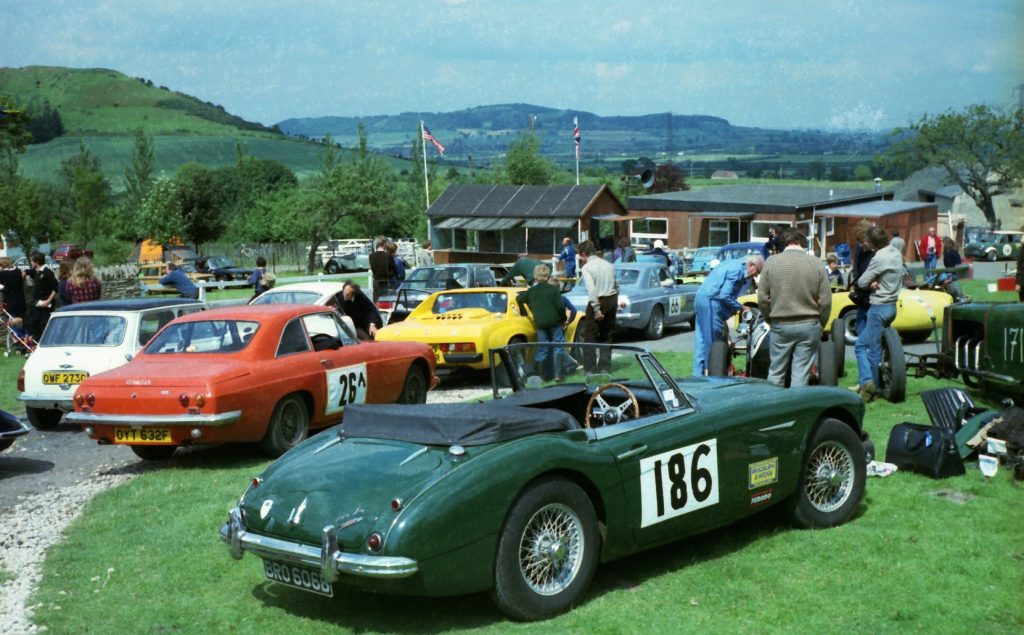 Interviewer: At Shelsley Walsh? “No, that picture was taken at Prescott, because the Championship runs at Prescott (Gloucestershire), Loton Park (Shropshire) and Shelsley (Worcestershire). So, that was me back into competition again. Not seriously, because I just used to do the rounds that I could, work used to prevent me from doing the full Championship. Anyway, I wouldn’t have been in contention for it. I did that for some years. In fact, I think probably the last time I did a Hill Climb was probably about 2006. I haven’t done one since. But, I enjoyed it very much.” Interviewer: Yes. It’s a lovely photograph because there are some interesting cars present. It was also a lovely day, wasn’t it? Your car is prominent there and that yellow car….. “It’s an AC 3000 and the Reliant Scimitar Coupé on the left there. Funnily, we had a Scimitar Coupe for the best part of twenty years, it was the garage companion for the Healey for a long time, but we sold that some years ago. So, I did the Hill Climbs for quite a few years, just going to the ones I could attend, just for the fun. Turner & Newall, (owners of Ferodo) the company I worked for, decided to sell the Transmission Retarder division and I was tasked with achieving the disposal. Self-Changing Gears (SCG) of Coventry bought it and they offered me a job too, so, that’s when we first came down to this part of the world. It was when I was working for SCG, for four years, that we were taken over by Cummins, the diesel engine people. I thought, oh, that’s a good opportunity to head back into the diesel engine business, so, I moved across to the parent company. By this time, I was looking after our defence business in Self-Changing Gears, and the railway business. So, Cummins took me on as their Defence Sales Manager, my main customers were Alvis, Vickers, Vickers Shipbuilding, etc. We were very much involved in a major project with Vickers Shipbuilding at Barrow – in – Furness. So, I moved up to Darlington, because that’s where my team of engineers were.” Interviewer: That’s why you said you had moved around a bit, yes. Almost like being in the Army. “Yes. So, we lived up there for just under seven years and, of course, that meant missing the Hill Climb scene. I did go to Harewood once but found Harewood Hill Climb absolutely useless for a road car, it’s a combination of steepness, it was a straight start, left, right, through a farmyard, left, straight up, and then along. So, Prescott is good for Healeys because it’s twisty. With the Healey you’ve got good bottom-end torque, accelerating out of the bends; whereas at Harewood, you need good higher speed on the straight stretches. Single-seaters etc. are massively quicker than even fast road cars at Harewood. So, we had those years up in Darlington. While there I had some body work done on the car.” Interviewer: Why, was it becoming rusty? Was that the reason? “The back hadn’t been done: it was bubbling terribly around the filler cap, you could see there was a hell of a lot of corrosion in there. The body work is a mixture of aluminium and steel. The aluminium sacrificially corrodes, in places you find there is nothing there, just the paint. So, I had the back end rebuilt. I took the car over to a guy in Scarborough, John Scott-Nelson and said “Look, I don’t want you to quote, because I know you will refuse to quote, just ring me up when you strip the car down and we’ll decide what needs doing”. So, I bought new skins for the doors. I had had to put a fibreglass rear wing on when the nearside was done in 1974, because you couldn’t get metal wings at that time. I got them to replace that with a steel wing. I had a completely new replacement shroud put on all around the boot lid. It was one that had been recovered by Murray (Scott-Nelson) from the States. One of Murray Scott-Nelson’s specialities was bringing cars and parts of cars back to the U.K. from the U.S.” Interviewer: Interesting. That’s where most of them were sold, of course. “The shroud on mine had a registration plate on it from Florida 1966, so it was a second-hand shroud, but it was in perfect condition. That was the last time the body work had a rebuild as such. That was done while we were living in the North of England. Then I was given worldwide responsibility for all our rail business, which was about sixty million dollars a year, of business for Japan, Korea, Holland etc. That was centred on Daventry, Warwickshire, so, we moved back down here, and we’ve been here ever since. Since living here we’ve done a few hill climbs at Prescott, just for amusement. We have also used the car on a lot of Classic runs which would often start from Shelsley.” Interviewer: Did you go to any ‘Breakfast Meets’ anywhere? Silverstone, for instance? “We (Midlands Automobile Club) run ‘Breakfast Meets’ at Shelsley. I think we were the first people to do them actually. Prescott now does them too.” Interviewer: How far is it from here to Shelsley? “About forty miles, whereas Prescott is only nineteen, which is why we came here originally, to this part of the world. I’ve been to a Breakfast Meeting at Prescott, with the Porsche, because the Club (MAC) had a get-together there. The lovely thing about the MAC, in Shelsley, is that it is not wedded to a particular make of car, so, whenever you go on Classic runs there can be all kinds of classics (shows a photograph). 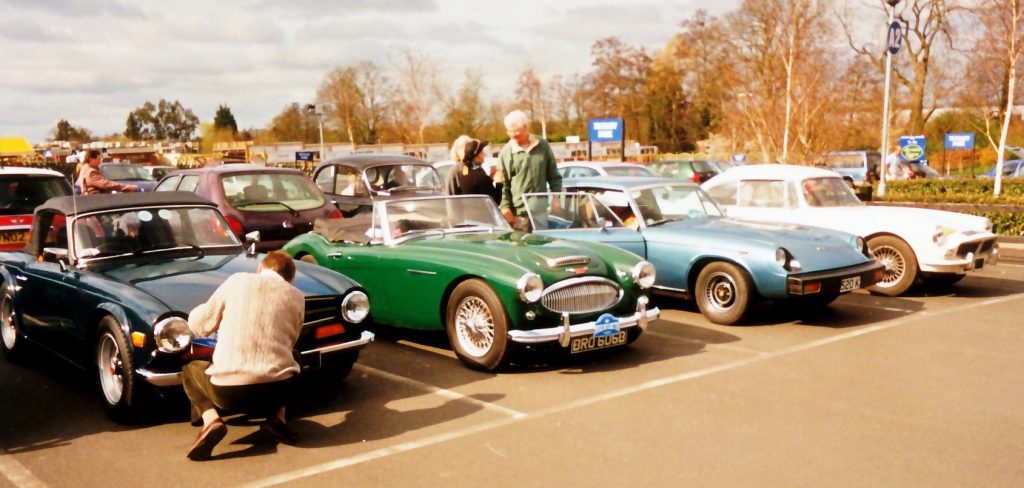 There’s a TR6, my Healey, a Jensen_Healey and a very rare Reliant Sabre Six (only 75 built). There will be Porsches and MGAs and Bs. Unfortunately, we don’t get too many pre-war cars now. There is one chap who now owns an MG 18/80 (1928 -33 the first true MG car, previous models had been badge engineered Morris cars. NM). He comes along in that and a chap with an MG M Type Midget ‘Cream Cracker’ [An ex-works trials car NM]. Other than that, most of them are post-war cars. It’s very interesting, chatting to everybody. I did belong to the Austin Healey Club for a year when I was working in Slough but, in that time, I found it rather disappointing. The Healey used to be parked outside our works on the Slough trading estate and I came out one evening to find a card under the wiper that said “why aren’t you in the Austin-Healey Club?” It turned out to be the chap with another Healey-Alvis. So, I did join, but, I found that, there was myself and a guy called Gary Bristow who owned one of the ex-Works Healeys, 67 ARX driven for him by Stuart Hands. So, he and I used to be chatting 3000s. On one occasion, to be sociable, I went to talk to a group of Sprite guys. I asked “How much work do you do on your cars? Have you done any tuning work?” “No, the garage maintains it” one of them replied. “Don’t any of you look after your cars?” I said. And none of them did. I’m not decrying it, I mean, socially, they enjoyed it, but unlike Gary and myself, they weren’t hands-on. The first time I saw Gary was at the Rose & Crown, Henley-on-Thames. I was just getting out of my car and I heard this fantastic breathy six-cylinder noise coming down the hill, changing down through the box. He told me that he’d put the Works triple Weber engine from 67 ARX into this standard AH 3000 road car while 67 ARX was being rebuilt. 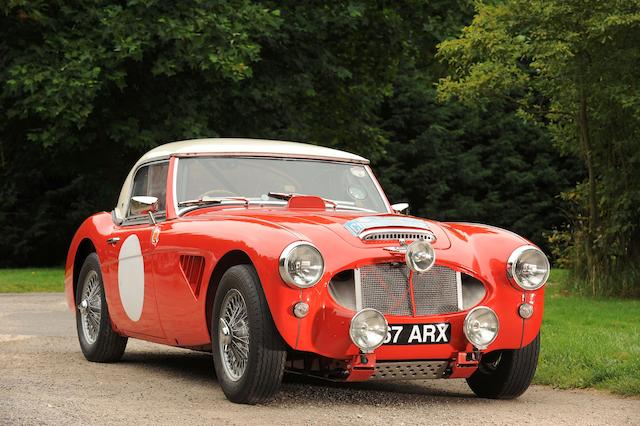 He gave me a ride in it, did that car go! Of course, the breathy noise from the Webers, was amazing. So, I didn’t renew my membership with the Club. I’m sure it’s much, much better now.” So, getting closer to the current period. Again, I had a card put under the windscreen wiper. I left the car parked in Chipping Campden (in the Cotswolds) main street, while we were up there having a meal. I came out and a chap called Peter Holdsworth had tucked his business card underneath the wiper. It just said Austin-Healey parts and service, etc. The business was on a trading estate which was is a bit south from here, not very far away. I decided it was time for a bit more work to be done on the body, because, by this time the car had got terrible cracking on the aluminium down this valley here (shows a photo of the car). It was looking a bit of a mess, bubbling along the wing lines. One thing that I’d always wanted to fit was the panel behind the front bumper, something that it should have.” Interviewer: Is that welded, spot welded on? “No. It’s just trapped behind, between the bumper brackets and the bumper. It’s just held in place by the bumper. The car didn’t have it when I bought it, so, I thought, well let’s get it. Really spruce up the car making it look a million dollars again. Because the front and back had been rebuilt at different times, there was slight shade differences in the paintwork. So, I got Peter Holdsworth to respray the whole car in one go. He’s out of business now. I don’t know what happened to him, he left, and the business just ceased to exist. They did a good job of my car. The only thing they did, which was rather infuriating, was they lost my body plate. Peter was very annoyed with his guys. He was away on holiday at the time and when he returned, he trawled through everything but couldn’t find the plate. He gave me one off another car, which I just reversed and stamped the chassis number on it. But I must make a new one because, when I do sell the car, which will only be when I can no longer drive (as this is being written, September 2020, the car is for sale. Not because David has stopped driving but because he finds it difficult to get under the car these days; part of the fun of ownership he says), people might query the plate that is on the car now. I need to make a new one. I have been desperately trying to find out the batch number, because Jensens used to put a batch number on the body. I’ve narrowed it down to a gap of about ten numbers, but, unfortunately, I didn’t make a note of the one for my car. That plate always has the number and the batch number for the body. I have not managed to run that to earth. Note – NM asked Reid Trummel if he could suggest a solution to David. Reid put him in touch with Steve Byers, the BJ 8 registrar. Steve was able to help David, who was delighted (12/05/2020). A concern of many years finally resolved. Peter fitted shorter front springs for me. He said, “You’ll find quite an improvement in the handling with those”. He also fitted braided brake pipes etc. to give that slightly better response. He also fitted a six-branch exhaust manifold for me, that is why the exhaust pipes come out on the near side now. I dispensed with the silencers that are under the rear floor on the Mark III, so, I’m sure it wouldn’t pass a legal noise test. It’s got a stainless system throughout, but, the six-branch was the thing that made most difference to the performance.” Interviewer: So, really, over the years, bit by bit …. just mention, how many years have you had it now? “Forty-six.” (Forty eight, at the time of publishing, NM) Interviewer: Crikey. So, over the years, bit by bit, you’ve improved it. You’ve put right things that were wrong with it, that you didn’t know about, but now, the things that you’ve done in recent years, you’ve actually improved. What carburettors, has it still got the? ….. Part Two –
Nick © carsceneinternational.com
|
The story of an AH 3000 MKIII with the same owner for 48 Years – Part One

Rootes Heritage Day at the British Motor Museum – Gaydon –...
Here is a summary of the Rootes Heritage Day - It was a fantastic event for car enthusiasts, especially those with an interest in...

Coventry MotoFest 2024 Report
In the U.K. you can never depend of the weather to treat outdoor events kindly but when it does those events are so much...
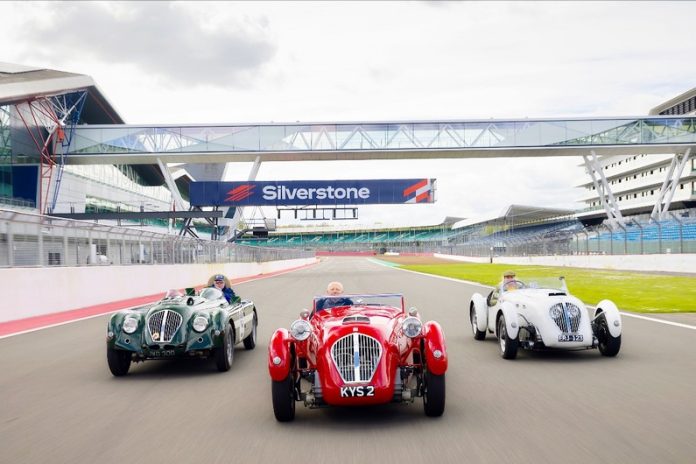
Healey Silverstone 75th Anniversary
CSI is please to bring you this 'Press Release' from Silverstone Festival 2024
"HEALEY SILVERSTONE CELEBRATES ITS 75th AT SILVERSTONE FESTIVAL
• Special milestone for racy roadster...

Healeys at the Classic Car & Restoration Show 2024
I made my annual visit to the 'Practical Classics' Classic Car & Restoration Show last Friday. As ever, it was a friendly and joyful...

Classic Car & Restoration Show Birmingham NEC 2024 – Report
It's always a pleasure to attend this annual event. Everyone you meet is friendly and courteous, the people on the various stands are keen...

MG Prototypes at the British Motor Museum
Last year I read various articles on how MG enthusiasts had spotted rare MG prototypes rotting away on the old MG Rover site at...

Historic Rally Car Register Open Day at Gaydon 2024 – Report
In previous years I have been pleased to publicise the Historic Rally Car Register Open Day held at the British Motor Museum, Gaydon, in...
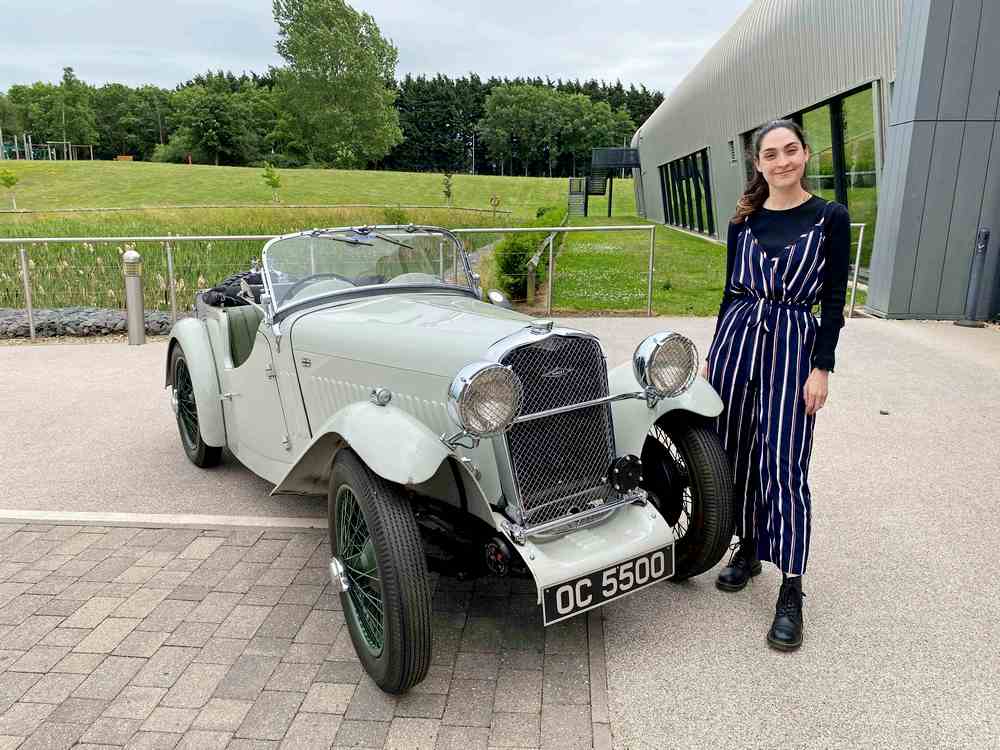
The Patrick Foundation supports ‘The Learning Hub’ at the British Motor...
A press release from the British Motor Museum -
"The British Motor Museum is delighted to announce the opening of ‘The Learning Hub’, a brand-new...


